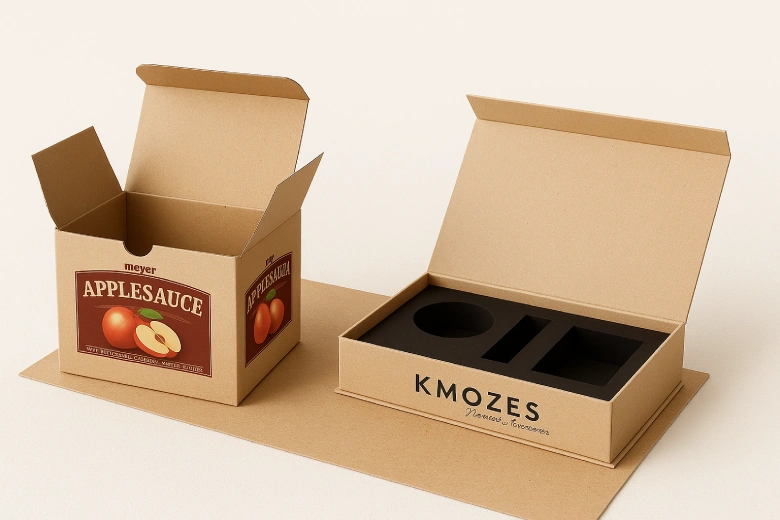Corrugated flutes are wave-shaped and found between layers of corrugated cardboard. They are designed to provide insulation, protection, and crush resistance in product packaging. The flutes create air pockets, strengthening and enhancing the material. They also help absorb shock and protect contents from external impacts.
Different corrugated thicknesses, such as A, B, C, E, and F flutes, offer varying levels of strength and cushioning. A-flute is the thickest and provides maximum protection, while the F-flute is thinner and ideal for lightweight packaging and printing clarity, offering versatile solutions for different packaging needs.
How Flute Size Impacts Packaging Strength
Flute size plays a crucial role in determining packaging strength. Larger flutes, like A-flute, provide excellent cushioning and are ideal for heavy-duty applications, absorbing more shock. Smaller flutes, like E or F-flute, offer greater structural integrity and are perfect for retail packaging, ensuring a smoother surface for printing and handling smaller items.
How to Choose the Right Flute Size for Your Packaging
Choosing the right flute size depends on the purpose of the packaging. For heavier items requiring more protection, the A-flute is suitable, while the B or C-flute works well for moderate protection and versatility. E-flute is best for compact retail packaging with fine printing.
Different Types of Corrugated Flutes
| Flute Type | Thickness (inches) | Purpose |
| E-Flute | 1/16 | Ideal for reducing storage space, packaging consumer goods, and providing a high-quality printing surface. |
| B-Flute | 1/8 | Suitable for packaging heavier items, providing a good printing surface, and offering moderate cushioning. |
| C-Flute | 3/16 | Most widely used for shipping cases, providing a balance between strength and cost. |
| A-Flute | 1/4 | Best for packaging fragile items that require extra protection, offering maximum cushioning and strength. |
| F-Flute | 1/32 | Used for very lightweight packaging and reducing storage space. |
E-Flute:
The E-flute is thin yet strong, offering excellent printing surfaces and structural integrity. It’s commonly used in custom retail boxes for cosmetics, electronics, and food items. E-flute is ideal for smaller, detailed prints, ensuring smooth surfaces and a professional finish, making it perfect for display packaging boxes.
B-Flute:
B-flute has a medium thickness, providing good crush resistance and stacking strength. It is widely used for canned goods, beverage trays, and shipping boxes. Its thinner profile compared to A-flute allows for better storage and transportation while offering sufficient protection.
C-Flute:
C-flute is a versatile, all-purpose flute used in various packaging applications like shipping cartons, glass, and furniture boxes. It offers a balance of strength, cushioning, and protection, making it suitable for heavy and fragile products. The c-flute is ideal for larger items requiring moderate protection. This makes C-flute a popular choice for larger packaging solutions, such as printed mailer boxes, where durability and product safety are key considerations.
A-Flute:
A flute is the thickest, offering maximum cushioning and protection. It’s ideal for heavy-duty packaging of fragile items like appliances, ceramics, or glassware. The large flute size absorbs shock well, making it a great choice for industries requiring extra protection during shipping.
F-flute is very thin and used for high-quality printing on small packaging, such as fast food and cosmetic packaging boxes. Its smooth surface enhances print quality, and its thin profile saves space while providing good strength for light products. Thus, it is ideal for branding-focused packaging.
How to Measure the Flute Thickness?
When you get your boxes, the edges look squished, and the flutes (the wavy part) aren’t as tall or even visible. Don’t worry—this is normal. Custom boxes are slightly compressed and cut during production, flattening the flutes at the edges.
To find the true thickness of a corrugated box, check the flutes in the middle of the box. These haven’t been compressed; thus, they show the actual thickness. The edges might look different, but the middle gives you an accurate measurement.
Environmental Impact of Corrugated Flute Thickness
Corrugated board thickness impacts protection and environmental sustainability. Thicker boards, like A-flute, use more material, increasing resource consumption, while thinner options, like E-flute and F-flute, minimize material use and reduce waste. Selecting the right thickness based on product requirements can help balance protection with environmental responsibility.
Select the Perfect Board Type
The board type, such as single-wall, double-wall, or triple-wall, plays a significant role in packaging performance. Single-wall boards are sufficient for light to moderate products, while double-wall boards enhance durability for heavier items. Consider the B-flute vs. C-flute corrugated performance when selecting the appropriate board type for your needs.
The Right Printing Type for Corrugated Packaging
Corrugated packaging doesn’t just have to be plain brown cardboard. In fact, you can print directly onto it, making it a great way to showcase your logo and products. There are a few printing options you can choose for corrugated material:
- Flexographic Printing: The most popular choice because it’s quick, easy, and cost-effective.
- Lithographic Printing: Best for large orders since it requires custom plates to guide the printing.
- Digital Printing: Perfect for small jobs as it doesn’t need custom plates.
Overall, you should choose the right printing type to make your packaging stand out and reflect your brand!
Summing Up
In summary, corrugated flutes are the wavy layers in cardboard that provide strength and protection. Different flute sizes (A, B, C, E, F) offer various levels of cushioning and durability, with the A-flute being the thickest and the F-flute the thinnest. Choosing the right flute size depends on your packaging needs, such as protection for heavy products or smooth surfaces for printing. Measuring the proper thickness involves checking the middle of the box. Thicker boards use more material, impacting sustainability, while printing options like flexographic, lithographic, and digital can enhance branding.
Contact Custom Box Makers if you are looking for sturdy corrugated boxes or don’t know which flute thickness is perfect for you.









